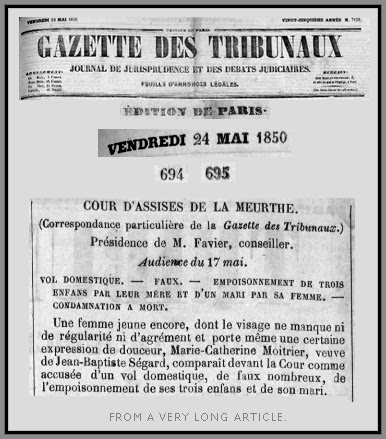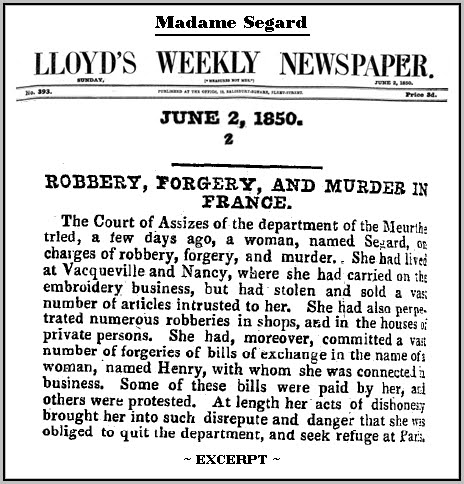[Untitled, Vermont Watchman & State
Journal. (Montpelier, Vt.), Jun. 27, 1850, p. 1]
***
FULL
TEXT (Article 2 of 3): A woman named Segard was guillotined at Nancy on the
8th, for having poisoned her husband and three children.
[“Foreign
Gleanings.” The Weekly Chronicle (London, England), Jul. 14, 1850, p. 3]
***
FULL
TEXT (Article 3 of 3): The Court of Assizes of the department of the
Meurthtried, a few days ago, a woman, named Segard, of charges of robbery,
forgery, and murder. She had lived at Vacqueville and Nancy, where she had
carried on the embroidery business, but had stolen and sold a vast number of
articles intrusted to her. She had also perpetrated numerous robberies in
shops, and in the houses of private persons. She had, moreover, committed a
vast number of forgeries of bills of exchange in the name of a woman, named
Henry, with whom she was connected in business. Some of these bills were paid
by her, and others were protested. At length her acts of dishonor brought her
into such disrepute and danger that she was obliged to quit the department, and
seek refuge at Paris.
There
she entered the service of a portrait painter, named Chabut, but after a few
days ran away, taking with her different articles of clothing and numerous
daguerreotype plates. These things she sold for sums much below their value. A
complaint was laid before the police, and she was arrested. An investigation
having been made into the charges against her at Nancy, proofs of different
robberies, and of not fewer than seventeen forgeries, were soon obtained. It was in the course of the
investigation that the more serious crime of murder was discovered. It appeared
that in 1842 her first husband, named Marchal, died, leaving a fortune of
between 6,000f. and 7,000f., one-fourth of which he directed should go to her,
and the remainder to their daughter Florine.
About this time, it is supposed, she resolved to get rid of
the poor child, in order to come into possession of all the money; and it was
specially noticed that she stated to several persons that an eminent physician
of the neighbourhood had assured her that her daughter, notwithstanding her
apparent good health, would not live long; whereas the physician never said
anything of the kind. A few months after Marchal’s death she married Segard,
and had by him two children, Arsène and Constant. Her conduct was scandalously
immoral, and led to frequent violent dissensions with her husband; and
eventually she took a profound antipathy against him. On the 27th of February,
1848, her daughter Florine died; on the 18th of March her son Arsène died; on
the 28th of the same month Constant, and on the 2nd of May her husband also
died.
All
four were taken ill in the same way. with violent vomitings, dreadful pains in
the bowels, and other symptoms of poisoning. The children expired after a few
days’ suffering; the husband lingered for three weeks. She called m medical men
to her children, but took care to keep them in the dark as to the nature of the
malady.
When
her husband first became ill she also sent for a doctor, but that gentleman
having expressed himself in terms which led her to believe that he suspected
foul play, she would not allow him or any other medical man to be again summoned.
Before the unfortunate man took to his bed she managed to persuade him, by
demonstrations of pretended affection, to make a will in her favour.
When
he died she displayed most unseemly joy—even the gravedigger, who attended the
funeral repast, was shocked at it. “I have been,” he said naievely, “to a great
many funeral repasts, but never saw one so merry.”
The
bodies of the deceased were dug up, and chemical analysis demonstrated that
poison existed in the bowels of each. After the reading of the indictment the
prisoner replied to the interrogatories put to her with perfect calmness and
great lucidity. She pretended that she was totally unable to state the cause of
the deaths of her husband and children. The whole of the evidence clearly
brought home to her the different charges of robbery, forgery, and poisoning by
means of arsenic. It was further proved that during her married and widowed
life she had been guilty of most licentious conduct. A notary’s clerk stated
that during her widowhood he, though a perfect stranger, having, in a call he
had made on business, jokingly observed that he would rather pass the night
with her than go home in the rain, she at once invited him to stay, which he
did. Notwithstanding all this, she pretended to be piously inclined,” and when
in prison awaiting her trial she wrote to the magistrates to request the
counsels of a confessor, that,” as she expressed it, “she might not lose her
immortal soul, as well as her honour.” With respect to the accusations of
having robbed the portrait painter, she created some indignation were also
exited by the proof that she had herself
written and caused epitaphs to be placed on the graves of her victims: –
“Here
lies the body of Joseph Arsène Segard on the 15th of March, 1848, aged ten months.”
“Here
lies the body of Anne Marie Florine Segard, who died the 28th of February,
1848, aged ten months.”
“Here
lies the body of Anne Marie Florine Marchal, who died the 28th of
February, 1848, aged eight years. This child, notwithstanding her tender years,
displayed rare qualities of mind; her obedience and modesty caused her death to
be deeply regretted by her mother, who has erected this monument to her
memory.”
“Here
lies the body of Jean-Baptiste Segard, aged thirty-seven. He was a good husband,
an affectionate father, and a Christian devoted to the poor. To her dear and
virtuous husband his grateful wife erects this monument. May he repose in
peace.”
After
hearing counsel for the prosecution and the defence, and the able summing up of
the judge, the jury returned a verdict of guilty, and the court condemned the
woman to death.. She heard the verdict and sentence unmoved, and walked away
with a firm step – she was, indeed the
only person in the court who was not labouring under profound emotion. During
the whole trial also she displayed extraordinary self-possession. She is
represented to be rather pretty, with a mild expression.
[“Robbery,
Forgery, And Murder In France.” Lloyd’s Weekly Newspaper (London, England),
Jun. 2, 1850, p. 2]
Victims:
M. Marchal, first husband, died 1842
Anne Marie Florine Segard, 10-months-old, died Feb. 28, 1848
Anne Marie Florine Marchal, 8-years-old, died Feb. 28, 1848
Joseph Arsène Segard, son, 10-months-old, died Mar. 18, 1848
Constant Segard, son, died Mar. 28, 1848
Jean-Baptiste Segard, 37, second husband, died May 2, 1848
***
***
FULL TEXT: Une affaire criminele que, en d'autres temps,
n'eût pas manqué d'exiter unn immense sensation, vient de se dérouler devant te
jury de la Meurthe.
Une femme, jeune encore, dont le visage manque ni de
régularité ni d’agrément, et port même une certain expression de douceur,
Marie-Catherine Moitrier, veuve de Jean-Baptiste Ségard, comparaît devant la
Coeur comme accusée d’un vol domestique, de faux nombreaux et de
l’empoisonnement de ses trois enfans et de son mari.
Decs poursuites commencés contre la veuve Ségard, à propos
d’escroqueries sans importance, ont mis la justice sur la trace des
empoissonnemens commis par cette femme plus de deux ans auparavant, et dont
l’impunité semblait lui être acquise.
Au commencement de 1848, cette femme a successivement
empoisonné un enfant qu'elle avait eu d'un premier mariage, deux enfans du
second lit, et enfin son mari.
M. Braconnot, chimiste; M. Blondelot, docteur en médecine,
et M. Simonin, ancien pharmacien à Nancy, experts commis à l’effet de
rechercher la présence de l'arsenic dans les restes des victimes dont la mort
et imputée à la veuve Segard, rendent compte à l'audience des opérations
auxquels ils se sont livrés.
Les tombes qu’ils avaient à interroger leur ont été
signalées par les inscriptions suivantes que la veuve Ségard y avait fait
graver.
« – Ici repose ie corps de Joseph-Arsëne Ségard, décédé le
25 mars1848, âgé de dix mois.»
« – Ici répose ie corps de Anne-Marie-Fiorine Marchal,
décédée ie 25 février 1848, âgée de huit ans. Cette enfant, maigre son jeune
age, montrait des facuités d'esprit peu ordinaires; son obéissance et sa
modestie l'ont fait regretter de sa mère, Marie-Catherine Moitrier, qui a fait
ériger ce monument à mémoire.»
« – Ci-gît ie corps de Constant Ségard, decédé le 31 mars
1848, âgé de quatre ans. Ce cher petit ange, dont l’occupation habituelle a été
de fair plaisir à sa tendre mère, a creusé par sa mort un vide immense dans son
coeur.»
« – Ici repose ie
corps de Jean-Bantiste Ségard, âgé de de trente-sept ans, bon époux, père
tendre et chrétien dévoué au soulagement des pauvres. A ce cher et vertueux
époux Marie-Caroline Moitrier, son épouse reconnaissante. Qu’il repose en
paix.»
La lecture de ces épitaphes, tracées par la main de la mère
et de l'épouse empoisonneuse, produit un sentiment d'indignation et d'horreur que
nous ne saurions exprimer.
Les experts eont unanimes à conclure 1e que les viscères de Jean-Baptiste Ségard, de
Florine Marchal, de Constant Ségard et d'Arsène Ségard renfermaient de l'arsenic sans qu'on puisse préciser ni
apprécier ia quantité de cette substance, qui a causé la mort.
2e Que ces viscères no contentent point de cuivre,
d'antimoine, de plomb, de zinc, ou d'autres substances métalliques capables de
donner la mort.
3e Que la terre du cimetière de Vacqueville, prise audessus
des cercuelis, ne contenait point d'arsenic à l'état soluble, et n'avait pu par
conséquent en céder la moindre parcelle aux corps qu'elle renfermait.
A l'appui de cette solution, les experts représentent des
tubes où l'arsenic est venu se fixer en anneaux métaitiques, et des fragmens de
porcelaine auxquels il s'est déposé en étoiles brilliantes.
Ils affirment que que l’arsenic a dû être ingéré pendant in
vie, et que d’apres les quantités qu’ils sont parvenus à extraire, il a dû
l’être en quantité suffisante pour donner la mort.
Après trois quarts,d'heure da délibération, le jury rapporte
un verdict àffirmatif sur toutes les questions.
L'accusée, ramenée à l'audience, entend ia lecture de ce
verdict sans témoigner de trouble.
La Cour prononce son arrét de mort.
La veuve Ségard reste impassibile au millien de l'émotion
des magistrats, des juges et de tout l'auditoire. Elle se lève et se retire
d'un pas assuré.
[Untitled (under “Cours et Trimbunaux.”), Journal des
Debats, Politiques et Litteraires (Paris, Frances), May 26, 1850, p. 2]
***
Pamphlets:
Pamphlets:
• Arrêt de la Cour d'assises de La Meurthe qui condamne à la
peine de mort Marie-Catherine Moitrier, veuve Ségard, convaincue d'avoir
empoisonné son mari et ses trois enfants, impr. Chassaignon, 1850, 1 page.
• Jugement rendu par la cour d'assises de la Meurthe dans
son audience du 17 mai 1850, qui condamne à la peine de mort, la nommée
Marie-Catherine Moitrier, Vve Ségard, entrepreneuse de broderies, d'abord à
Vacqueville et actuellement à Nancy [pour avoir commis un grand nombre de faux
et empoisonné son mari et ses trois enfants.- Le volontaire républicain. Signé,
Eugène Hermany de Dorval], Charmes, impr. L. Buffet, 1850, 8 pages.
• Nouveau recueil contenant le célèbre
jugement de Marie-Catherine Moitrier ; une complainte ; le jugement des époux
Turpin, de Briollay [pour l'assassinat par le mari de l'amant de sa femme, le
cordier Hubert] ; un vieux de la vieille, etc., etc., par Boin André , impr. Cosnier et Lachèse, 1851.
***
For links to other cases of woman who murdered 2 or more husbands (or paramours), see Black Widow Serial Killers.
***
For similar cases, see: Female Serial Killer Bandits
***
[1236-6/9/19]
***
[1236-6/9/19]
***









No comments:
Post a Comment